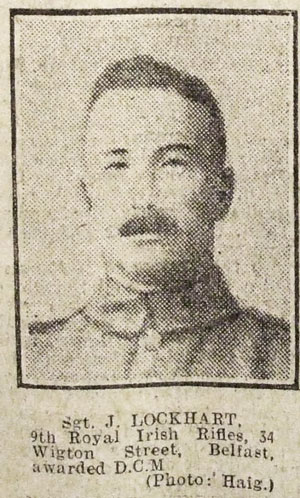Sergeant John Lockhart, DCM

John Lockhart was born on 23 June 1889 at 37 Halliday's Road, Belfast, the second of ten children of labourer James Lockhart and his wife Rebecca (née McKinley). On 26 February 1911 he married Margaret Cahoon in St Anne's Church of Ireland Parish Church, Belfast. The couple had four children over the next ten years. At the time of the 1911 Census they were living at 35 Seventh Street, Belfast, John working as a labourer and carter. Soon after they moved to 34 Wigton Street.
Lockhart enlisted in the 6th (Inniskilling) Dragoons Service Squadron between 10 and 13 November 1914 (No. UD/133). On 6 October 1915 he embarked for France with his squadron, which was then serving as divisional cavalry to the 36th (Ulster) Division.
In June 1916 the Inniskilling squadron joined with C and F Squadrons of the North Irish Horse to form the 2nd North Irish Horse Regiment, serving as corps cavalry to X Corps.
In August-September 1917 the Regiment was disbanded, its men transferred to the Royal Irish Fusiliers, an infantry regiment. Most, including Lockhart, were transferred on 20 September and posted to the 9th (Service) Battalion – renamed the 9th (North Irish Horse) Battalion – joining it in the field at Ruyaulcourt five days later. Lockhart was issued regimental number 41148 and posted to B Company.
He probably saw action with the battalion at the Battle of Cambrai in November and December 1917.
On 20 December 1917 he was admitted to No.2 General Hospital at Le Havre, having fallen ill, but was released to a convalescent depot on 7 January. He returned to his battalion in time to see action in the fighting withdrawal from St Quentin from 21 to 28 March 1918 during the German spring offensive and at Mount Kemmel in April.
On 22 July 1918 Lockhart took part in a trench raid on Shoddy Farm in the Ypres sector. He later wrote a letter to the family of one of the officers listed as missing after the raid, 2nd Lieutenant F.J.E. McFarland:
Having seen y[ou]r adv[ertisement] in the Belfast Evening Telegraph of 2nd Lieut McFarland I was with him about the latter end of July when my company were out on a raid one night. Mr McF came out with us to[o], but he should not have been with us as he belonged to another company, but he came and done splendid work. When our company got word to retire we came back in the usual way. It wasn't till a few hours after I found it [sic] Mr McFarland was missing along with a few more, and there was a party out looking for them, but couldn't get any one, so I never seen him anymore, so he must have been taken prisoner, for we went over the same ground a few days after, and couldn't find any trace of anyone. I feel very sorry for him as he was a splendid soldier. This is all the information I can give you Sir
On 1 January 1919 Lockhart was awarded a Distinguished Conduct Medal for gallantry in this and other actions during 1918, his the citation reading:
For conspicuous gallantry and good work in the line during the past year, including the following engagements:- St. Quentin, March, 1918; Kemmel, April, 1918. He has at all times shown great devotion to duty, and a splendid example to his company. He has shown great keenness in carrying out minor enterprises, and showed great gallantry in leading a bombing party, when his company carried out a raid in July 1918.
He was awarded the Belgian Croix de Guerre in September 1919.
On 8 March 1919 he was demobilised and transferred to Class Z, Army Reserve.
After the war Lockhart returned to Belfast and again found work as a labourer. He died at his home, 31 Wigton Street, on 2 July 1956 and was buried in the Templepatrick Churchyard.
Image, from the Belfast Evening Telegraph, kindly provided by Nigel Henderson, Researcher at History Hub Ulster.
This page last updated 29 March 2023.
